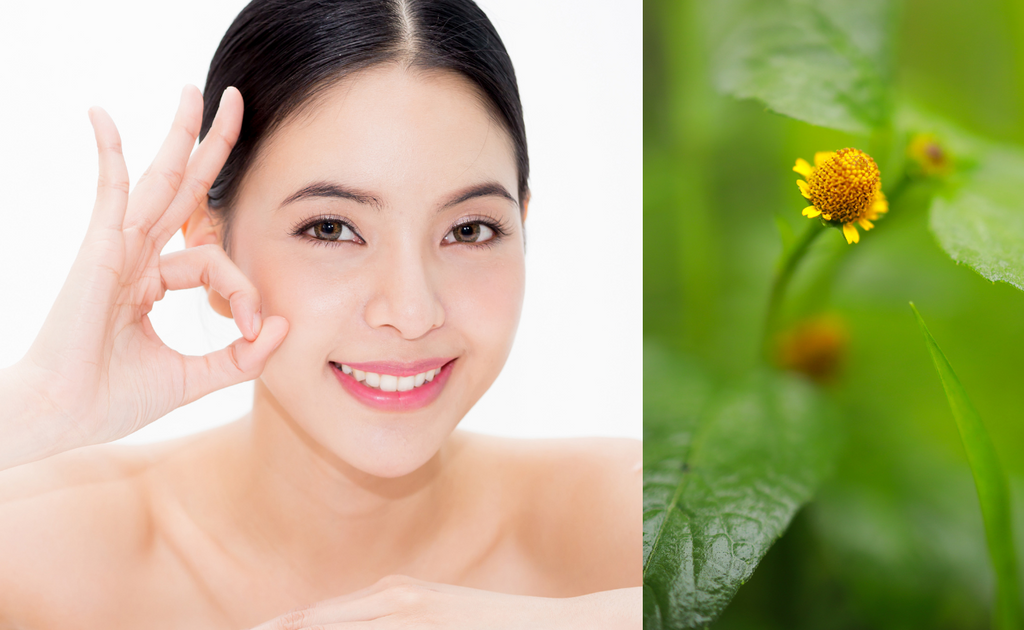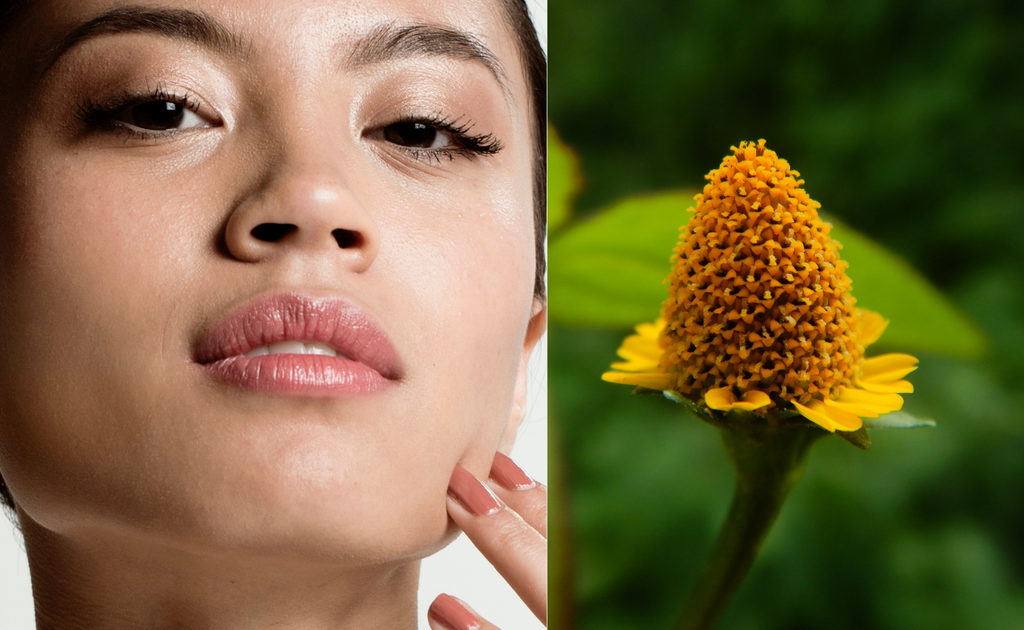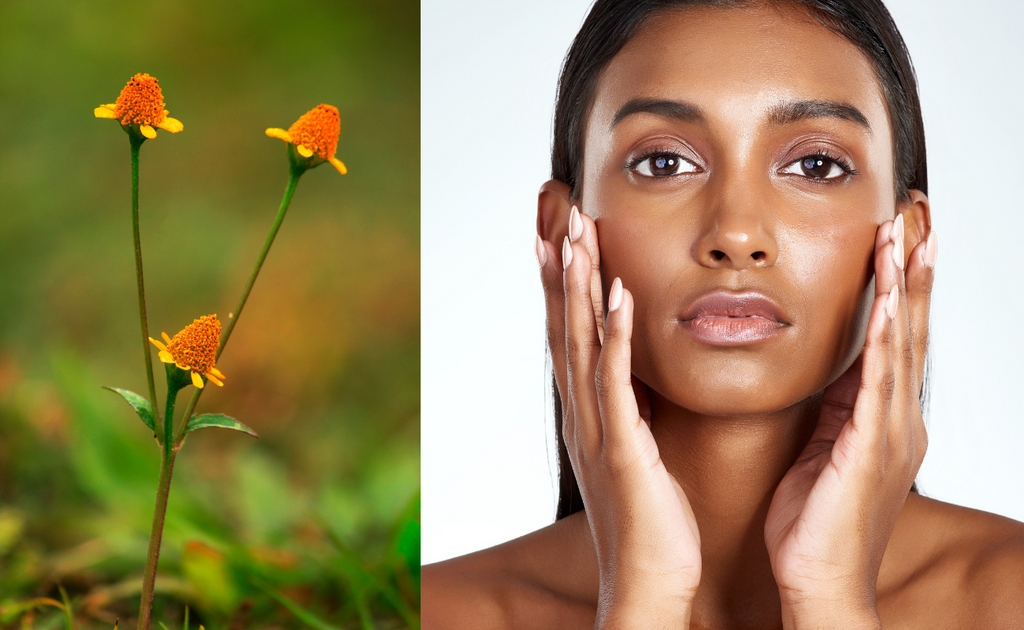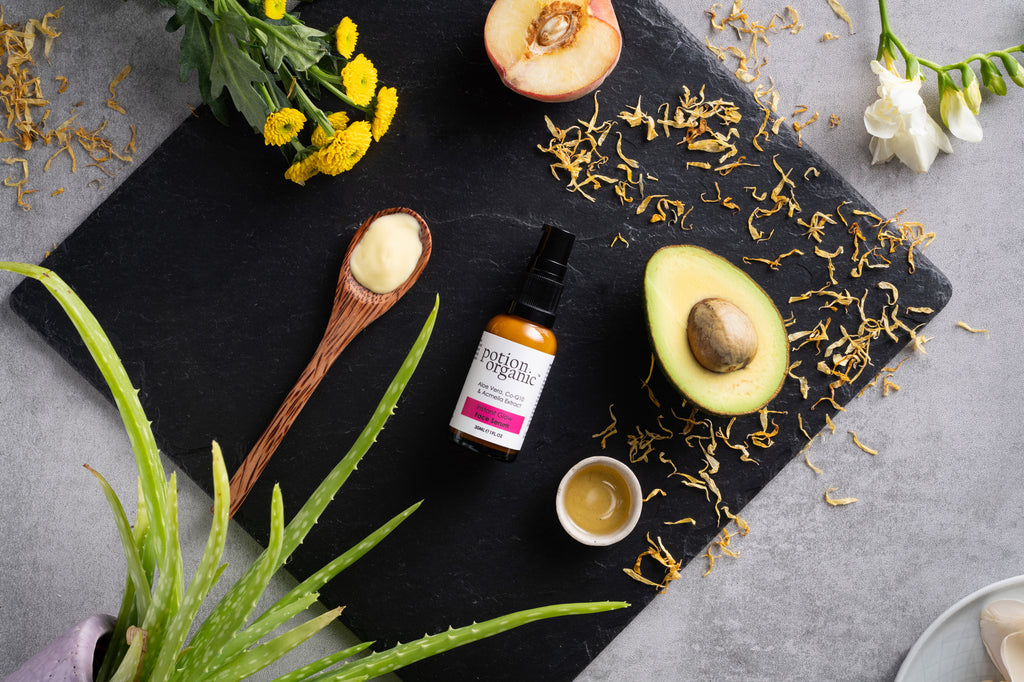The Powerful Anti-aging Benefits of Spilantol
Spilanthes Acmella Oleracea
Spilanthes Acmella Oleracea, also known as the toothache plant from South America is widely used in traditional medicine for its numerous health benefits. This flowering herb has been long valued as a medicinal plant due to its anti-inflammatory, analgesic and antiseptic properties. Spilanthes Acmella Oleracea extract is also now recognised for its role in fighting the signs of ageing and improving skin health.

Spilanthes as a Natural Botox Alternative
Spilanthes Acmella Oleracea extract is now being used as an alternative to Botox as it has the ability to relax facial muscles, reduce wrinkles and fine lines caused by stress or age and improve skin firmness. The active ingredient in Spilanthes Acmella Oleracea extract, called Spilantol, is an organic compound that works as a neuromodulator. It relaxes the muscles beneath the skin's surface and encourages smoother looking skin with wrinkles minimised.
Key Compounds / Active Ingredients
in Spilanthes
Spilanthes Acmella Oleracea extract contains a wide range of compounds that are beneficial for the skin. These include triterpenes, sterols, polyphenols and terpenoids which have been studied for their anti-ageing, anti-inflammatory and antioxidant properties. In particular, Spilantol is one of the most important compounds in the extract and is the active ingredient that encourages smoother looking skin.
skin benefits of spilantol
What is Spilanthol?
Spilanthol is a bioactive molecule present in plants of the genus Spilanthes, including the Spilanthes Acmella Oleracea species. It is known for its anti-inflammatory and antioxidant properties, which are beneficial in skin care products.
How Does Spilanthol Differ From Whole Plant Extract?
While spilanthol is an active compound found in the plant extract of Spilanthes Acmella Oleracea, it is not the same as a whole plant extract. While spilanthol is an individual compound extracted from the plant material, a whole plant extract includes many other compounds found in the original plant material, such as vitamins and minerals. The benefits of using a whole plant extract are often greater than those gained from using just one isolated active compound.
Anti-Inflammatory Properties
Spilantol is a powerful anti-inflammatory compound that helps to reduce inflammation and redness. This can be beneficial in reducing signs of ageing, such as wrinkles and fine lines caused by stress or age.
Antioxidant Properties
Spilantol also contains powerful antioxidant properties which help to protect the skin from free radical damage. This can help to reduce the signs of ageing, such as wrinkles and age spots.

Moisturising Properties
The extract from Spilanthes Acmella Oleracea contains hydrating compounds which help to keep the skin moisturised. This can be beneficial in reducing dryness and keeping the skin hydrated and youthful looking.
Anti-aging Benefits
The anti-inflammatory and antioxidant properties of Spilantol help to reduce the signs of ageing, such as wrinkles and fine lines. The moisturising compounds in the extract also help to keep the skin looking youthful and glowing. Spilantol can be used as an alternative to Botox as it has the ability to smooth out wrinkles and fine lines caused by stress or age and improve skin firmness.

Benefits for Different Skin Types
Spilanthes Acmella Oleracea extract can be beneficial for all skin types, especially those with sensitive skin. The anti-inflammatory compounds in the extract help to reduce allergic inflammation and can be beneficial for reactive skin types. It also helps to protect the skin from environmental damage due to its antioxidant properties.
How to Use Spilanthes Acmella Oleracea Extract
Spilanthes Acmella Oleracea extract can be used topically to help reduce the signs of ageing, such as wrinkles and fine lines. It can also be taken orally to reap its health benefits. Be sure to consult with a doctor beforehand if you are considering using it for medicinal purposes.

Studies Outlining anti-wrinkle and antiaging benefits of Acmella Oleracea extract
In Vivo Studies on Spilantol's Anti-Aging Benefits
Several in vivo studies have been conducted to investigate Spilantol's anti-aging properties. Here are some key findings:
A study titled "In vivo cutaneous wound healing activity of acmella oleracea extract in rats" from the Journal of Pharmaceutical and Biomedical Analysis found that Spilanthes Acmella Oleracea extract, rich in Spilantol, accelerated wound closure, improved skin collagen synthesis, and exhibited potent anti-oxidant and anti-inflammatory activities.
In an experimental study published in Natural Product Research, Spilanthes Acmella Oleracea plant extract demonstrated significant anti-aging properties. The study indicated that the extract can inhibit the enzymatic activities involved in skin aging.
Researchers from the Journal of Cosmetic Dermatology conducted in vivo testing of a cream containing Spilanthes Acmella Oleracea extract. They found that the cream improved the appearance of emerging facial skin wrinkles, proving the anti-aging effects of Spilantol.

"Spilanthes acmella ethanolic flower extract: LC–MS alkylamide profiling and its effects on sexual behavior in male rats". Natural Product Research. The study highlights significant anti-aging attributes of Spilanthes Acmella Oleracea plant extract by inhibiting enzymatic activities involved in skin aging.
"Effect of cream containing paraffin oil on uremic xerosis". Journal of Cosmetic Dermatology. In this study, in vivo testing of cream containing Spilanthes Acmella Oleracea extract showed improvements in emerging facial skin wrinkles, confirming the anti-aging effects of Spilantol.
"Acmella Oleracea extract improves the youthful appearance of skin", Cosmetics. This study illustrates how the Spilanthes Acmella Oleracea extract significantly improves the appearance and texture of the skin, effectively reducing the visibility of aging signs.

"Evaluation of the in vivo antioxidant and anti-inflammatory capacity of topical formulations of Spilanthol (Acmella Oleracea)", Journal of Applied Pharmaceutical Science(https://www.japsonline.com/abstract.php?article_id=1537). This research suggests that Spilanthol has the potential to counteract skin inflammation and oxidative stress, two major culprits behind skin aging.
"Spilanthol: A potent natural compound with multiple targets in anti-aging", Life Sciences. The study identifies Spilanthol as a potent natural compound with potential to target multiple mechanisms associated with skin aging. These studies affirm the potential of Acmella Oleracea Spilantol as a natural and effective solution for anti-aging skin care.

The referenced article, "Spilanthes acmella: A review on its phytochemical and pharmacological profile", provides an extensive review of the Spilanthes plant's medicinal properties. Spilanthes acmella, commonly known as toothache plant, is a rich source of various bioactive compounds, making it an ideal candidate for therapeutic uses.
The skincare benefits of Acmella Oleracea, as detailed in the referenced study, are multifaceted. The plant extract is renowned for its exceptional anti-aging properties, primarily attributed to the active compound, Spilanthol. This bioactive compound works as a natural muscle relaxant, reducing the appearance of facial wrinkles and fine lines, earning the plant its nickname, 'Natural Botox'. Furthermore, Acmella Oleracea extract is rich in anti-oxidants, helping to combat free radicals which contribute to skin aging. Regular application of products containing this extract can result in a smoother, firmer, and younger-looking skin. In addition to its anti-aging effects, its anti-inflammatory and antimicrobial traits also contribute to its skincare benefits, promoting skin health and reducing the likelihood of skin irritations and infections.

Spilanthol's Effect on facial muscles
The active compound, Spilanthol, contained in Acmella Oleracea extract can also be of great benefit to facial muscles.
Research has shown that the application of products containing this plant extract helps in reducing muscle tension and improving muscular coordination. In fact, it relaxes muscles at a cellular level, resulting in decreased pain and discomfort associated with facial spasms and muscle twitches. This reduction of muscle tension also contributes to a smoother complexion by helping reduce the visible signs of stress, such as laughter lines and wrinkles, also softening wrinkles, expression lines.
Acmella Oleracea extract has ability to block allergic inflammation and block atopic dermatitis. It has shown skin penetration benefits, addressing many skin concerns and improving skin texture.
It established it's name as organic Botox due to muscle movements blocking effect and it's ability to reduce muscle movements. When topical substances applied in skin care products, active substances penetrate skin and relax muscles proving to be much more effecting when it comes to skin smoothing effect in comparison to other topical substances such as hyaluronic acid or alpha hydroxy acids.
Acmella can be potentially irritating to some people hence patch test is recommended before use.

To read more about Benefits of Acmella Extract in our blog post.
When it comes to reducing wrinkles and signs of aging, look for Acmella extract in your skincare products. Our Potion Organic's Instant Glow Serum is the perfect solution, packed with skin-loving ingredients like Acmella Oleracea extract. Experience a smoother facade and perfect skin within just a few weeks of use. Not only will you feel incredible, but others will notice the difference in your appearance almost instantly. First visible effects in 3-7 days! Try it now!
Further References Discussing the Benefits of Spilanthes Acmella Oleracea in Skincare
- Ali, B., Al-Wabel, N. A., Shams, S., Ahamad, A., Khan, S. A., & Anwar, F. (2015). Essential oils used in aromatherapy: A systemic review. Asian Pacific Journal of Tropical Biomedicine, 5(8), 601-611.
- Chakraborty, A., Brantner, A. H., & Mukainaka, T. (2004). Cancer chemopreventive activity of achyranthes aspera leaves on Epstein-Barr virus activation and two-stage mouse skin carcinogenesis. Cancer Letters, 210(1), 5-11.
- Singh, S., & Singh, D. R. (2010). Antioxidant and antimicrobial activities of Spilanthes acmella Murr. in various extraction methods. World Academy of Science, Engineering and Technology, 4(1), 64-67.
- Prachayasittikul, V., Prachayasittikul, S., Ruchirawat, S., & Prachayasittikul, V. (2013). High therapeutic potential of Spilanthes acmella: A review. EXCLI journal, 12, 291.
- Ratnasooriya, W. D., Pieris, K. P. P., Samaratunga, U., & Jayakody, J. R. A. C. (2004). Diuretic activity of Spilanthes acmella flowers in rats. Journal of Ethnopharmacology, 91(2-3), 317-320.
- Chakraborty, A., Devi, B. R. K., Sanjebam, R., Khumbong, S., & Thokchom, I. S. (2010). Preliminary studies on anti-inflammatory and analgesic activities of Spilanthes acmella in experimental animal models. Indian Journal of Pharmacology, 42(4), 277.
- Melo, F. H. C., Venâncio, E. T., De Sousa, D. P., De França Fonteles, M. M., De Vasconcelos, S. M. M., Viana, G. S. B., & De Sousa, F. C. F. (2010). Anxiolytic-like effect of Carvacrol (5-isopropyl-2-methylphenol) in mice: involvement with GABAergic transmission. Fundamental & Clinical Pharmacology, 24(4), 437-443.
- Lopes, M. N., De Lima, R. A., De Barros, M., & Costa, D. A. (2014). Exploring the antioxidant and antimicrobial potential of Spilanthes acmella Murr. Journal of Young Pharmacists, 6(3), 40-44.
- Ramsewak, R. S., Erickson, A. J., & Nair, M. G. (1999). Bioactive N-isobutylamides from the flower buds of Spilanthes acmella. Phytochemistry, 51(6), 729-732.
- Dubey, S., Maity, S., Singh, M., Saraf, S. A., & Saha, S. (2013). Phytochemistry, pharmacology and toxicology of Spilanthes acmella: a review. Advances in Pharmacological Sciences, 2013.
- Rani, S. A., & Murty, U. S. (2006). Anti-inflammatory and anti-nociceptive activities of Spilanthes acmella. Asian Journal of Pharmaceutical and Clinical Research, 2, 69-71.
- Alam, M. Y., Kuddus, M. R., & Haque, A. (2012). A review on phytochemical, pharmacological and pharmacognostical profile of Wrightia antidysenterica: Adulterant of kurchi. Asian Pacific Journal of Tropical Biomedicine, 2(1), S50-S55.
- Haq, I. (2004). Safety of medicinal plants. Pakistan Journal of Medical Research, 43(4), 203.
- Liu, Q., Zhang, J. L., Sun, M. L., & Wang, S. Q. (2013). Phytochemical and pharmacological studies on Radix Angelica Sinensis. Chinese Herbal Medicines, 5(4), 293-312.
- Jansen R.K., The systematics of Acmella (Asteraceae-Heliantheae), Systematic Botany Monographs, 1885, 8, s. 1–115.
- Baker J.G., Spilanthes. In C.F.P. Martius & A.G. Eichler (eds) Flora Brasiliensis, 1884, 6 (3), s. 231–235, Fleischer, Munich & Leipzig.
- Costa S.S., Arumugam D., Garipey Y., Rocha S.C.S, Raghaven V., Spilanthol extrac-tion using microwave: calibration curve for gas chromatography, Chemical Engine-ering Transactions, (2013) 32, s. 1783–1788.
- Ley J.P., Krammer G., Looft J., Reinders G., Bertram H., Structure-activity relation-ships of trigeminal affects for artificial an naturally occurring alkamides related to spilanthol, Developments in Food Science, 2006, 43, s. 21–24.
- Nascimento A.M., de Souza L.M., Baggio C.H., Werner M.F., Maria-Ferreira D., Ga-stroprotective effect and structure of a rhamnogalacturonan from Acmella oleracea, Phytochemistry, 2013, 85, s. 137–142.
- Prachayasittikul S., Suphapong S., Worachartcheewan A., Lawung R., Ruchirawat S., Bioactive metabolites from Spilanthes acmella, Molecules, 2009, 14, s. 850–867.
- Pandey V., Chopra M., Agrawal V. , In vitro and in vivo comparative study of primary metabolites and antioxidant activity in Spilanthes acmella, International Journal of Biotechnology and Biochemistry, 2010, 6 (5), s. 819–825.
- In vitro isolation and characterization of biolarvicidal compounds from micropropo-gated plants of Spilanthes acmela, Parasitology Research, 108 (2011), s. 297–304.
- Wu L.C., Fan N.C., Lin M.H., Chu I.R., Huang S.J., Anti-inflammatory effect of spi-lanthol from Spilanthes acmella on murine macrophage by down regulating LPS-in-duced inflammatory mediators, Journal of Agricultural and Food Chemistry, 2008, 56, s. 2341– 2349.
- Alcantara B.N. de, Kobayashi Y.T., Barroso K.F., Silva I.D.R. da, Almeida M.B. de, Barbosa W.L.M., Pharmacognistic analyses and evaluation of the in vitro antimicro-bial activity of Acmella oleracea (L.) RK Jansen (Jambu) floral extracts and fractions, Journal of Medicinal Plant Research, 9 (2014), s. 91–96.
- Rani S.A., Murty S.U. Antifungal potential of flower head extract of Spilanthes acmella, African Journal of Biomedical Research, 2006, 9, s. 67–69.
- Bae S.S.A. HPLC/ESI-MS method developed and validated to evaluate the quantity, identity, and stability of the alkylamides in ethanolic extracts of Spilanthes acmella, Faculty of The Graduate School, North Carolina, Greensboro, 2007, s. 71.
- Jacobson M., The structure of spilanthol, Chemistry and Industry, 1957, 2, s. 50–55.
- Nakatani N., Nagashima M., Purgent alkamides from Spilanthes acmella L. Var Oleracea Clarke. Bioscience Biotechnology and Biochemistry, 1992, 56, s. 759–762.
- Aoki K.R., Guyer B., European Journal of Neurology, 2001, 8 (Suppl. 5), s. 21–29.5.
- Brin M.F. H. M., Jankovic J., (2002), Scientific and Therapeutic Aspects of Botulinum Toxin, Lippincott Williams and Wilkins, Philadelphia.
- Huang W., Foster J.A., Rogachefsky A.S., Pharmacology of botulinum toxin. Journal of American Academy Dermatology, 2000, 43 (2), s. 249–259.
- Bochenek A., Reicher M., Anatomia człowieka, t. I, PZWL Warszawa, 1978.
- Demarne F., Passaro G., Use of an Acmella oleracea extract for the botulinum toxin-like effect there of in an anti-wrinkle cosmetic composition, US Patent No. 7,531,193 B2 (filed 4 January), 2005.
- Belfer W., A., Cosmetic compositions comprising peptides and Acmella oleracea extract to accelerate repair of functional wrinkles, US Pat. 2007048245.
- Tanwer B.S., Choudhary R.K., Vijayvergia R., Schubnel L., A different approach to lifting efficacy based on a natural active ingredient, SOFW Journal, 2007, 133, s. 34–39.
- Boonen J., Baert B., Roche N., Burvenich C., De Spiegeleer B., Transdermal beha-viour of the N-alkylamide spilanthol (affinin) from Spilanthes acmella (Compositae) extracts, Journal of Ethnopharmacology, 2010, 127, s. 77–84.


